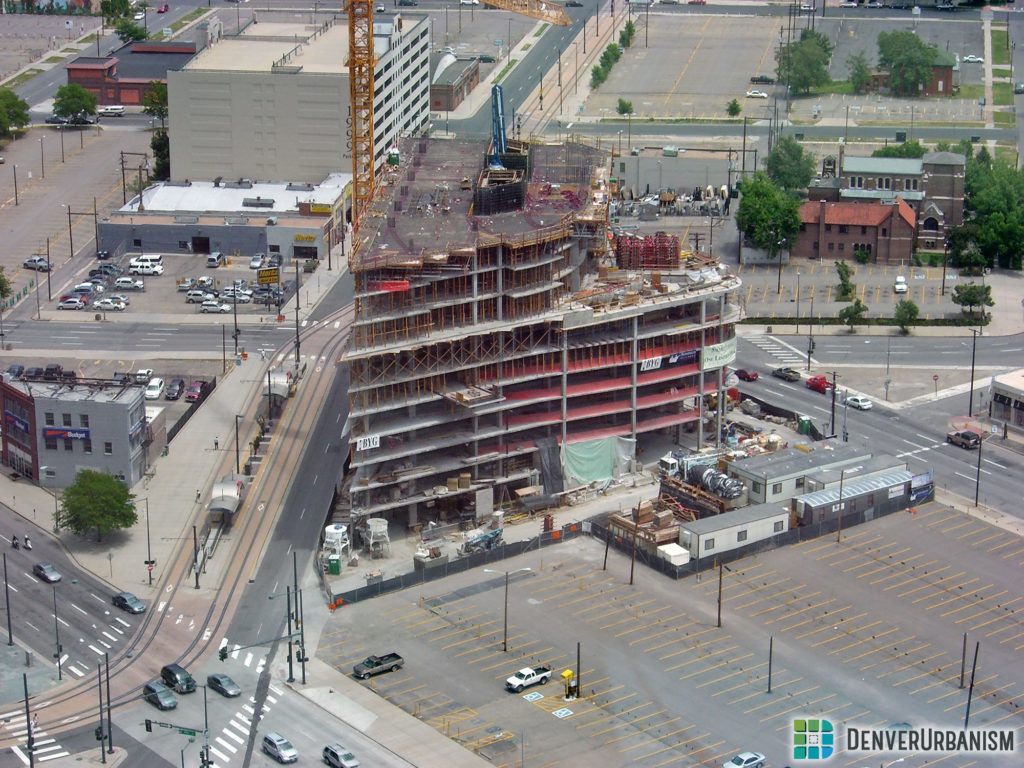There’s a triangular piece of land in Denver that is bounded by 20th Street, Welton Street, 20th Avenue (College Lane) and Lincoln Street. This is its story.
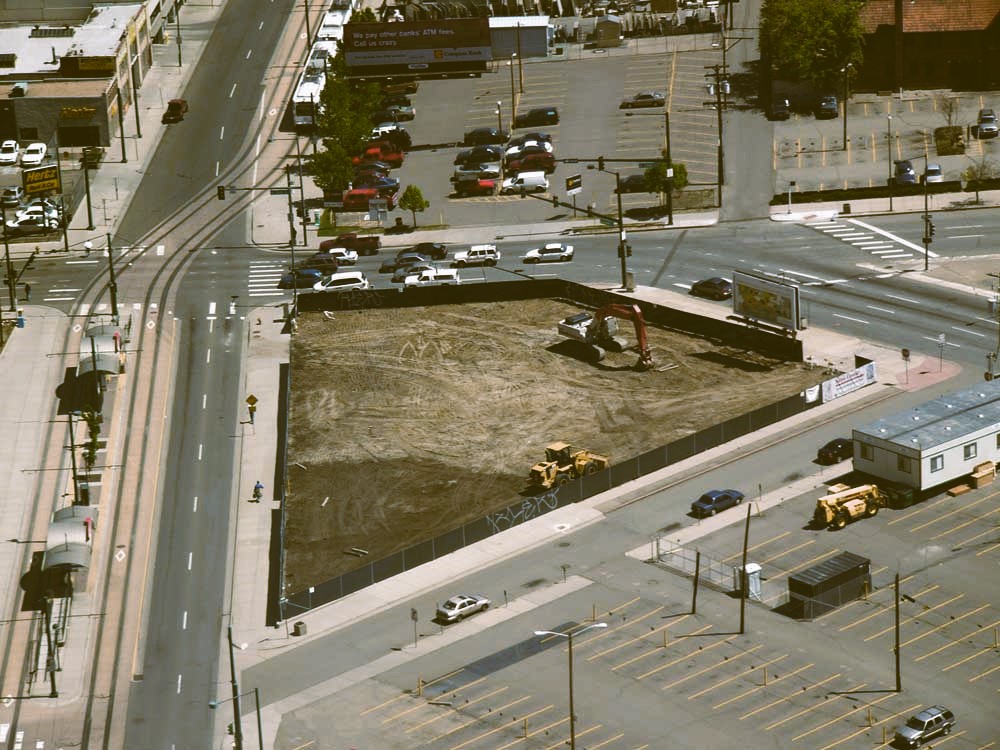
Back in 1864: Denver City
Back in 1864 this plot of land was located “far across the open country to the eastward” of Denver City, which was struggling to take shape near the confluence of Cherry Creek and the South Platte River.
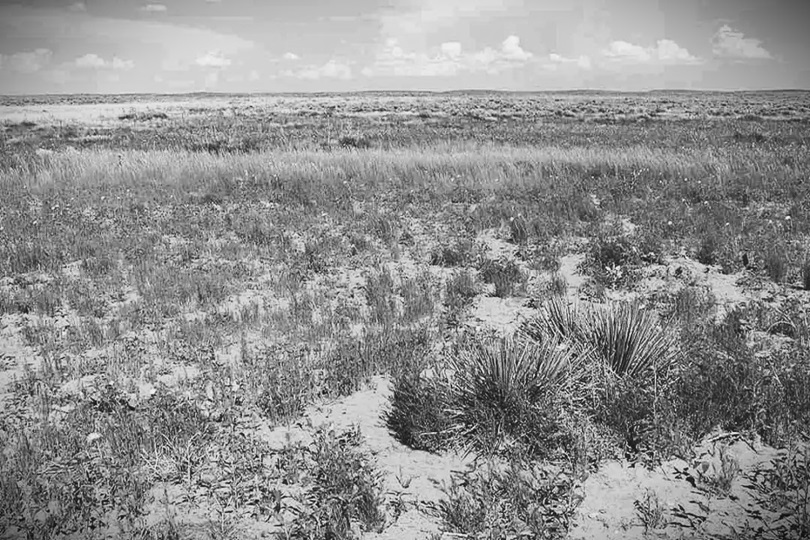
As noted in the book The History of Denver, “This period in Denver’s career the town in itself and by itself was not a pretty place. Its natural surroundings were magnificent, but no amount of local pride and patriotism, no stretch of partisan and partial enthusiasm, could make the town appear a thing of beauty. Its treeless, grassless, bushless condition gave it an exceedingly uninviting appearance; its motley, irregular, ugly structures of brick, frame, or lug were calculated to cause nightmare in the brain of an unseasoned visitor.

It is probable that nowhere else in the world were ever seen such architectural horrors, and combinations of architectural freaks and wretchedness, as those presented in the American frontier towns of a generation age. It would seem that human ingenuity would be incapable of producing results so uniformly frightful—that the law of chance, if it may so be called, ought to and would have brought in an occasional something to vary the dreary monotony and relieve the ferocity of ugliness. But it never did so.“
The Prairie Dogs Were Little Disturbed

Also at that time, far out to the eastward in an area where “the prairie dogs were little disturbed,” (now Capitol Hill) Henry C. Brown built a little frame house as evidence of his homestead right. He had entered a claim for one hundred and sixty acres on April 15th of 1864 at the price of two dollars and fifty cents per acre. On May 11, 1864, Alfred H. Clements also entered a claim for (pre-empted) the quarter-section (“Clements’ Addition”) next to Brown’s.

These lands had previously been surveyed in 1859 by E.D. Boyd, who “surveyed pretty much all of the Denver there was at that time.”

Clements then paid Mr. Brown one hundred dollars to build him a small frame house near 20th and Welton as evidence of his homestead right. Clements then made various improvements to his homestead property by planting trees and shrubbery, and also added a fence around the property.
Caleb B. Clements Built a Small Brick House
In the summer of 1865 Caleb B. Clements built a small brick house on the Alfred Clements homestead site. It was one of only three structures that existed east of Broadway at that time.
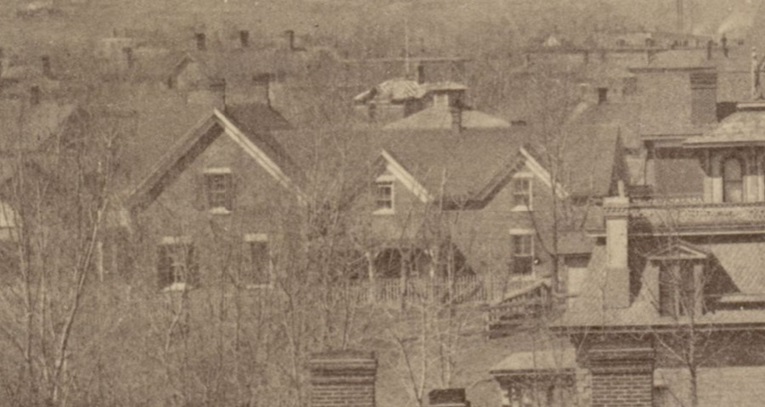
Soon lots were being purchased by individuals across the Clements Addition. On January 23, 1869 Alfred Clements then sold and conveyed all of his interest in his lands to his brother Caleb Clements who created some chaos in the area.
As noted in the Rocky Mountain News, on January 13, 1870, Caleb Clements “replatted the tract, making the streets and passages run through it in a different direction, running the streets diagonally across the lots previously conveyed by his brother. The resurvey then had closed all the old streets and alleys and established new ones, running in a different direction, which latter survey was adopted by the city authorities without inquiry or investigation and are the thoroughfares now in use.”
On January 12, 1872 Caleb sold and conveyed all of his interest in his lands to Richard T. Clements who continued selling lots and parcels in the Clements Addition.
JARVIS HALL

Jarvis Hall, an Episcopalian school for boys, was founded by Bishop Randall and was located about a mile from the city of Golden, Colorado “on an eminence which commands a fine view,” donated by C. C. Welch. During construction in 1869 Jarvis Hall was near completion when a “violent gale of wind” left the project in a pile of ruin. Reconstruction of Jarvis Hall immediately commenced and the school was finally dedicated in October of 1870. Disaster struck again On April 4, 1978 when Jarvis Hall was completely destroyed by fire.
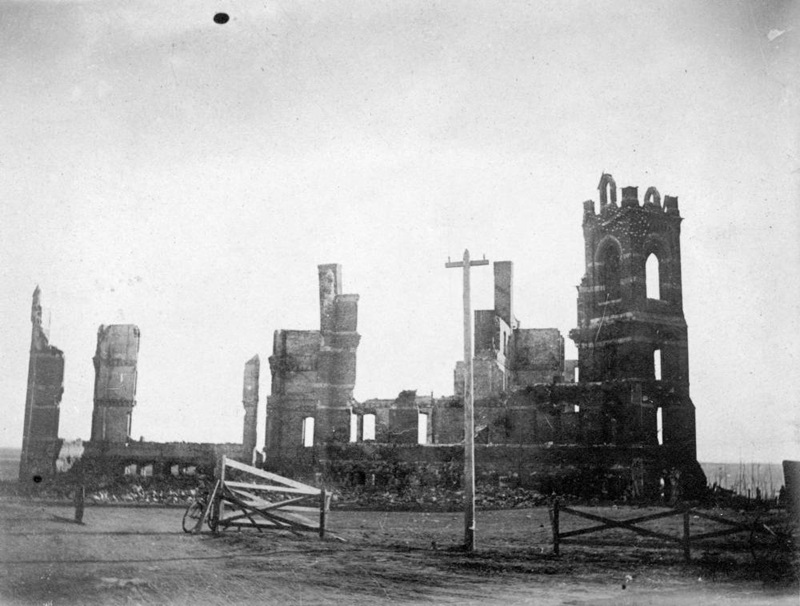
X-28248
In June of 1879 the Episcopal convocation met to address the “Jarvis Hall question.” It was quickly decided to build a new school in Denver. The site chosen was a plot of land at 20th and Welton Street, previously owned by Caleb Clements and located right next door to the small brick house he had built in 1865. The Clements house was used in connection with the new school building. Improvements were made to it including the addition of rooms for servants, laundry and kitchen rooms.
Construction soon commenced and by September Jarvis Hall was ready for occupation. A Rocky Mountain News reporter noted, “the building occupies one of the most pleasant sites in the city.” A very detailed description of the new school appeared in the August 10, 1879 edition of the Rocky Mountain News.

Z-11782 and WHJ-10458


ST. JOHN’S CATHEDRAL
An extension of the frame addition to the old brick church had been made in 1870. In 1874 a movement was started to erect a new building, but owing to financial stress nothing came of it. In 1878, while on a health-seeking tour around the world, Rev. H. Martyn Hart of England visited Denver on his way and preached a sermon in the St. John’s Church in the Wilderness. He made such a good impression on the little church in Denver that the Vestry asked him to come and be the Rector of Saint John’s.
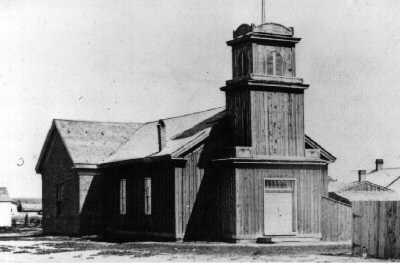
The Vestry won Hart over and in September of 1879 he moved his family from London to Denver. Soon after, Bishop John Franklin Spalding announced his intention to institute a “Cathedral system” for Colorado and named Hart the Dean and incorporated “The Bishop and Chapter of the Cathedral of Saint John the Evangelist, Denver, Colorado.” It was decided that a new cathedral would be built.
On January 23, 1880 The Rocky Mountain News reported:
At a meeting of the vestry and congregation of St. John’s Episcopal church—the pro cathedral—on Wednesday evening, the Jarvis hall site was chosen as the place on which the new cathedral is to be erected. The vote in favor of this location was fortyone to sixteen. Work will be commenced at once upon the building, and it is calculated that the edifice will be completed and ready for occupation within the present year. The plans of the new structure were exhibited at the meeting and elicited a strong approval from those present. The new cathedral will be an imposing edifice of great architectural beauty. Dean Hart informed the congregation that the designs were made upon the general plan of an Episcopal church in Montreal, which, in his opinion, is the most beautiful church building in the world. The cost of the structure will be about $60,000, and from its elevated position it will form a striking feature among the buildings of the city.
The corner stone of the new cathedral was laid on September 21, 1881 by the Grand Master of the Masons of Colorado. According to the Rocky Mountian News, reserved seats for the laying of the corner stone were available from Ingol’s jewelry store, Daniels and Fisher’s dry goods store, Chain and Hardy, Stone’s book stores, Eastman & Bostwick, Clayton’s hat stores, and at the Grand Central hotel.
On December 13, 1880 the ladies of the Parish Aid society of the Episcopal church opened their bazaar at 6 o’clock in the evening, where supper was provided “for all those who may wish to try its excellence.” The Rocky reported that, “It is to be hoped that this bazaar will be extensively patronized by all, as the proceeds are to be devoted to the purchase of the finest organ this side of Cincinnati, which will be placed in the new cathedral of St. John’s.”
In November of 1880 progress on the cathedral continued, as noted in the Rocky:
This handsome edifice is progressing very rapidly, and already gives evidence that it will be a handsome architectural ornament to this city. The magnificent sum of $2,000 has been given by a citizen to be expended on a memorial window to the memory of the late Mr. Thomas Bayaud, a citizen who was held in great esteem for his noble Christian character. It is to be hoped that other generous doners will be found anxious to contribute the money to perpetuate the memory of others among the many honored citizens of Denver who have passed away from life. Dean Hart has been very earnest in his efforts to obtain a building that would be an enduring architectural monument to the queen city of the plains, and in all of the details of the interior nothing should be common—these memorial windows should be works of art, not the common blotches of colored glass which are too frequently seen. In fact, every surrounding of the beautiful temple should be an honor to those who reared it, and the pride of the city in which it stands.
The Cathedral Will be Opened Today


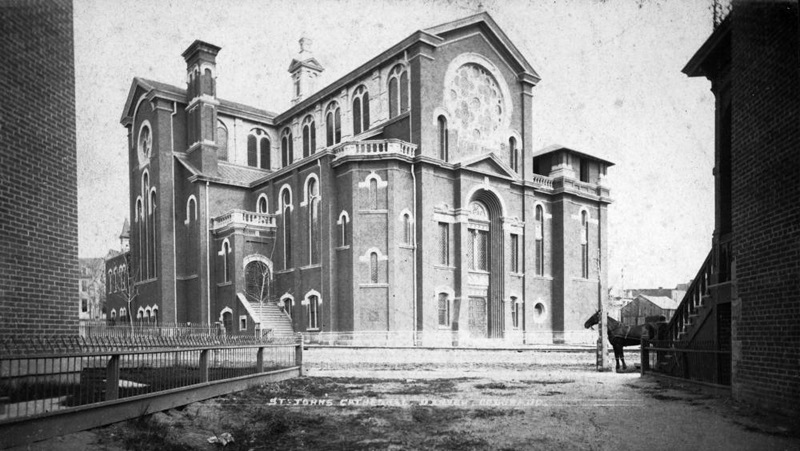
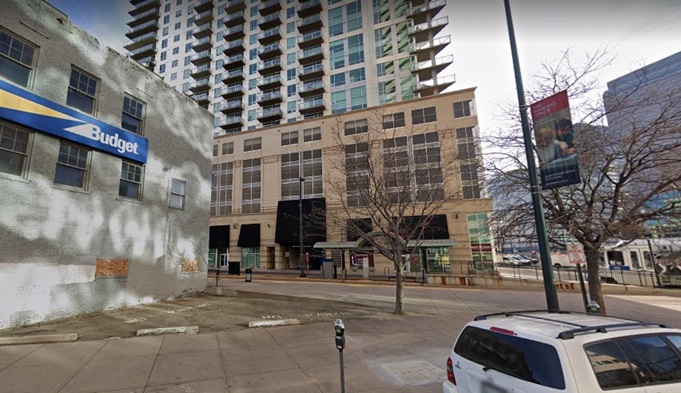


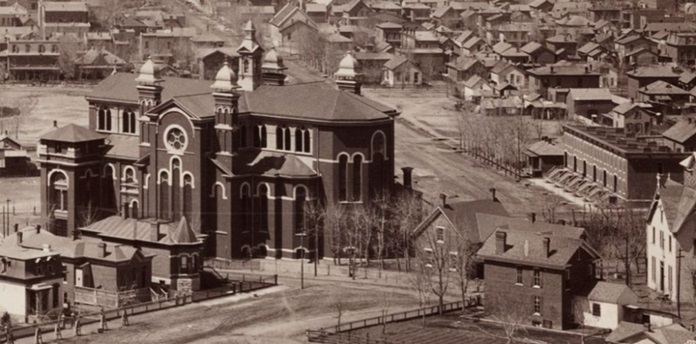
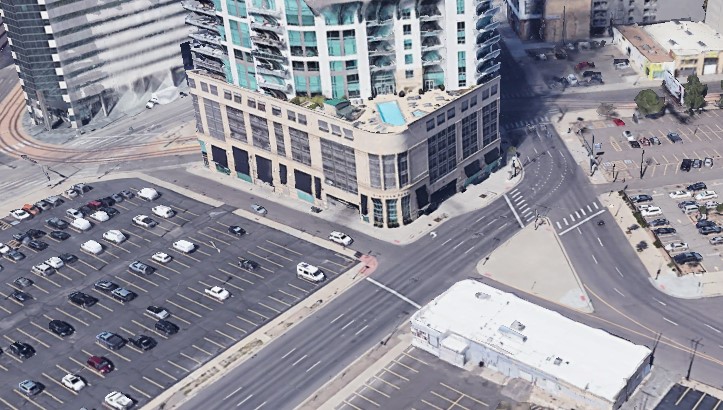

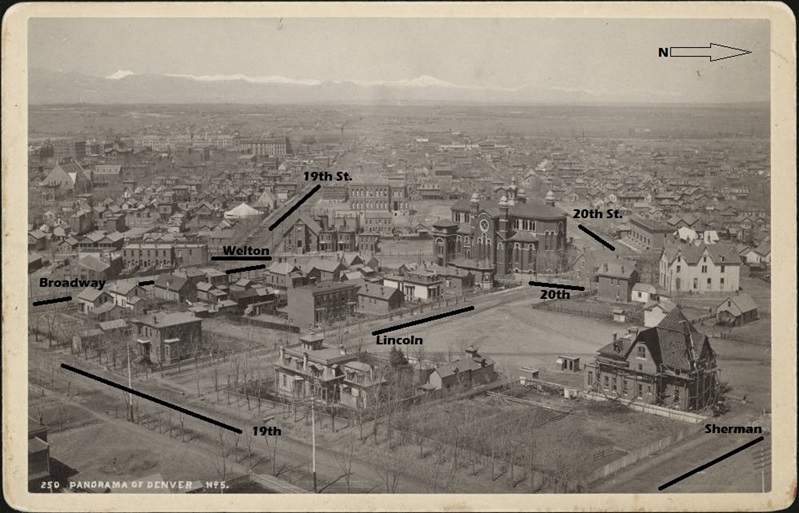
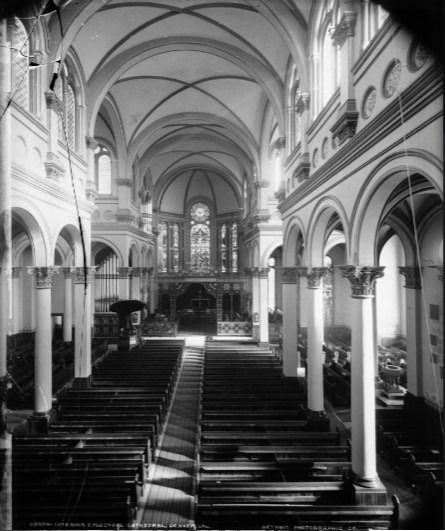





1903: The Fire
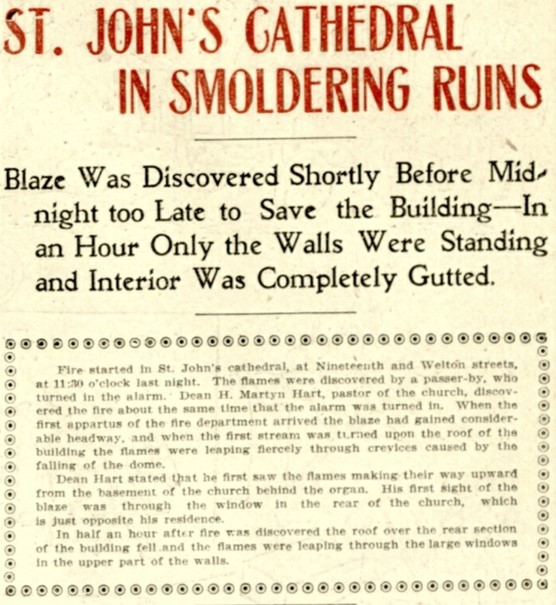
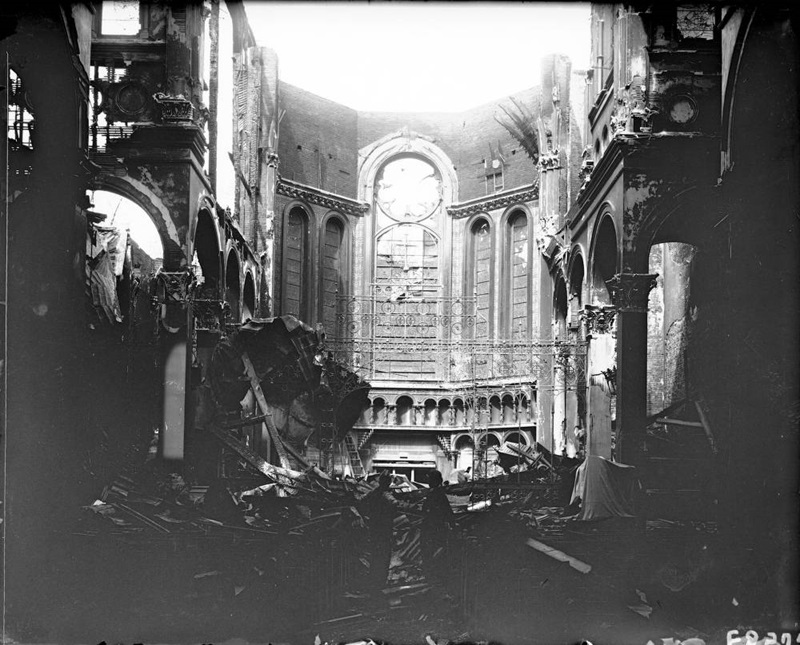
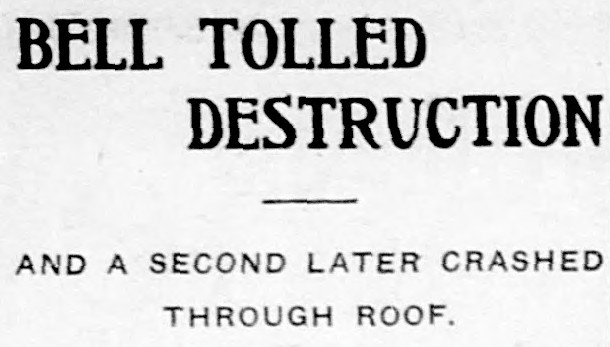
Fire started in St. John’s cathedral, at Nineteenth and Welton streets, at 11:30 o’clock last night. The flames were discovered by a passer by, who turned in the alarm. Dean H. Martyn Hart, pastor of the church, discovered the fire about the same time that the alarm was turned in. When the fire apparatus of the fire department arrived the blaze had gained considerable headway, and when the first stream was turned upon the roof of the building the flames were leaping fiercely through crevices caused by the falling of the dome. The fire quickly crept up from the basement and gained most headway on the roof. As soon as the roof began falling the entire interior of the structure became a mass of flames and the firemen were driven from the building. The large organ was the first object destroyed by the fire This was almost consumed before the flames were discovered. All of the large stained glass windows in the rear part of the building were destroyed. Many of these had been presented to the church as memorials and represented a total value of $6,000. Shortly after the fire had been discovered Dean Hart stated his belief that it was of incendiary origin and that some person had started it immediately under the organ. The building was open so that any person might enter. Another theory of the origin of the fire which would account for the burning of the roof of the building first, is founded on the fact that repairs have been made at the church during the last few day and a number of electric light wires had been placed in the auditorium of the building. It is believed by some familiar with the work which was going on that these wires had not been properly insulated. Repairs and improvements on the church amounting to over $15,000 had just been completed. A number of very valuable ornaments representing the figures of the Passion Play at Oberammergau were recently received at the church from the East. These figures were carved in oak by Joseph Meyer and were valued at many thousands of dollars They were completely destroyed. Thirteen of the figures had already been placed in the positions in the auditorium. Four had not yet been set up and these were saved but they lost their value through the destruction of the remainder of the set. The first of the stained glass windows to be destroyed was a large round one above the altar. The figure in this window was a reproduction of the famous painting of the Madonna and her child. It was valued at $1,500 and was presented to the church only a short time ago. The ten great streams of water tore big rifts in the cornice and the tops of the walls, sending a deluge of spray over the Sumer. Smoke black as ink rolled through costliest windows from the factories of England, pierced by tongues of fire and varied again by white puffs or starred by millions of flying sparks. Vast crowds, awed to silence, blocked every street and avenue leading to the scene and packed the cathedral grounds. Dean Hart roused from his bed chamber at the midnight hour.. with felt hat drawn close over his head, rushed hither and thither in great distress frantic because he unable to do anything to save his beloved edifice. His family, with blanched faces, sat on the rear steps of his dwelling, and were soon surrounded by sympathetic friends. Slowly the fire crept forward to the center of the cathedral and the firemen on the north moved with it, but all their work was powerless to avert the total destruction of the interior, and the torrent of water only seemed to madden the flames. Two measured strokes of the bell at 12:45 announced the fall of the sweet toned instrument which for years has called the members of the parish to worship. There was one clear stroke as the bell started down from the tower and a mufflled sound a second later, when it crashed into the debris. That was all. Portions of the roof on the south end of the church began to give way about this time, and soon the whole south wing covering fell in. As the painted iron crumpled up in the seething ruins there was a strong odor very much like burning oil, but it was only the iron and its coating becoming a prey to the flames.-Boulder Daily Camera, Volume 13, Number 51, May 15, 1903
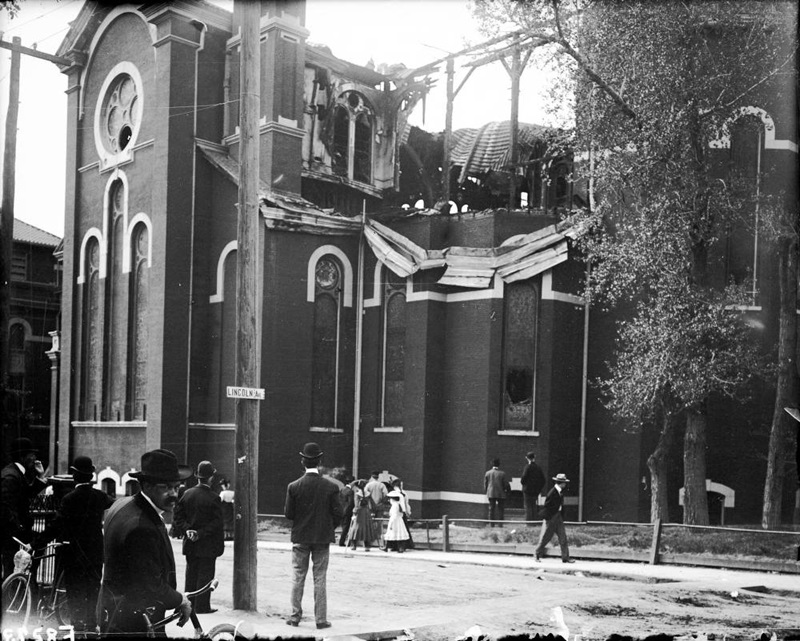

That the St. John’s cathedral was destroyed by an incendiary is the belief of the police and they are now hunting the man who, they believe, committed the deed. He is Charles Nadeau, who served a five-year sentence for stealing the communion service of the cathedral and desecrating the altar. That was in March, 1899. He was arrested a few days later and was sentenced on March 15. When he was taken to Canon City he declared time and again that he would get even with the church authorities for prosecuting. And that he did so is the opinion of the police.
The last time, the detectives can find that he was seen in Denver, was only a few nights before May 14. On that night St. John’s cathedral was destroyed by fire. Nadeau has never been seen since that time. Dean Hart, at the time, insisted that it must have been of incendiary origin, but the police apparently scoffed at the idea. They believed it had been caused by defective insulation of the electric wires. Nevertheless, since that time they have been hunting for Nadeau. and it is probable that he will be arrested within a few days.-The Rocky Mountain News (Daily), Volume 44, Number 249, September 6, 1903
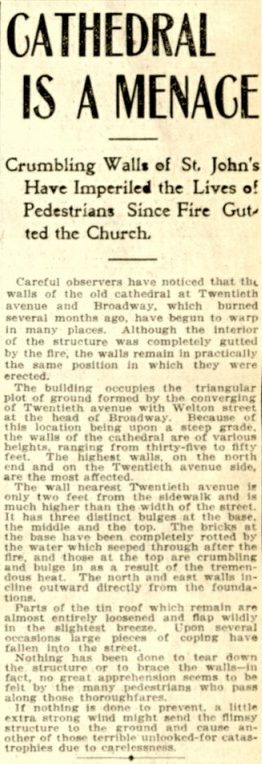


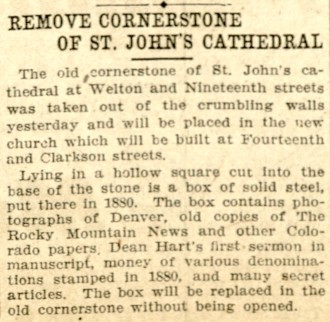




Hotel Crest
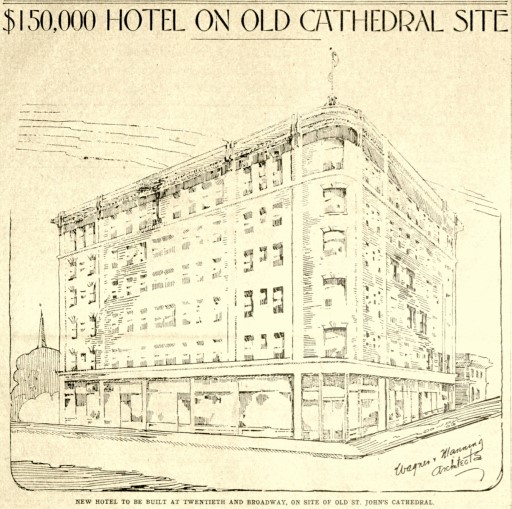







20th Street Extension
The extension of 20th Street through to 20th Avenue was discussed as far back as 1884 but didn’t take place until 1913-14.


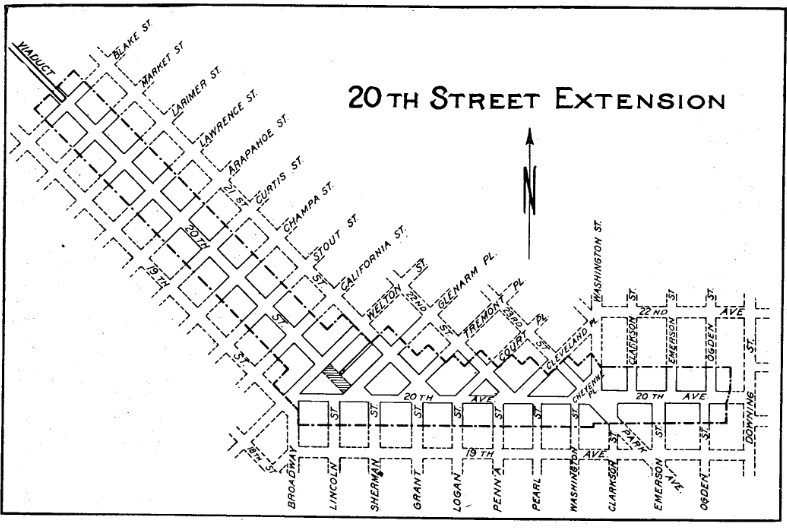

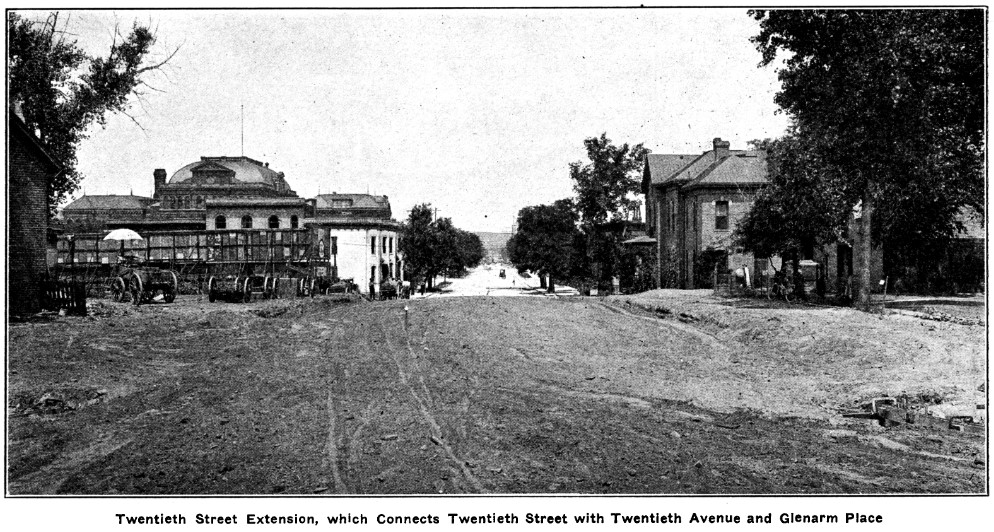
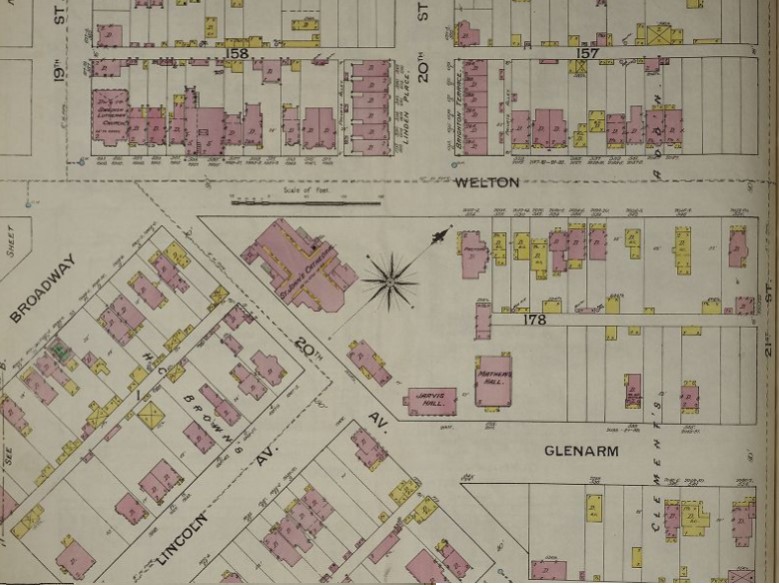
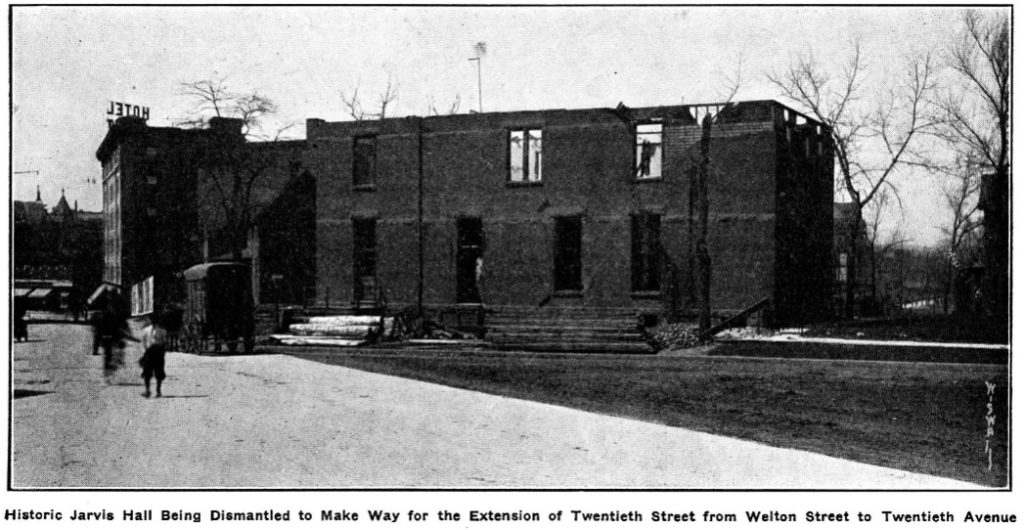

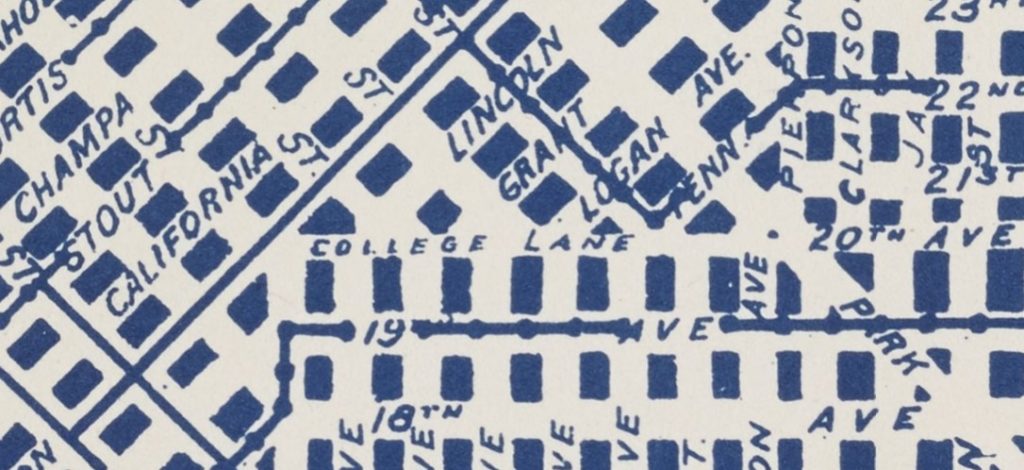




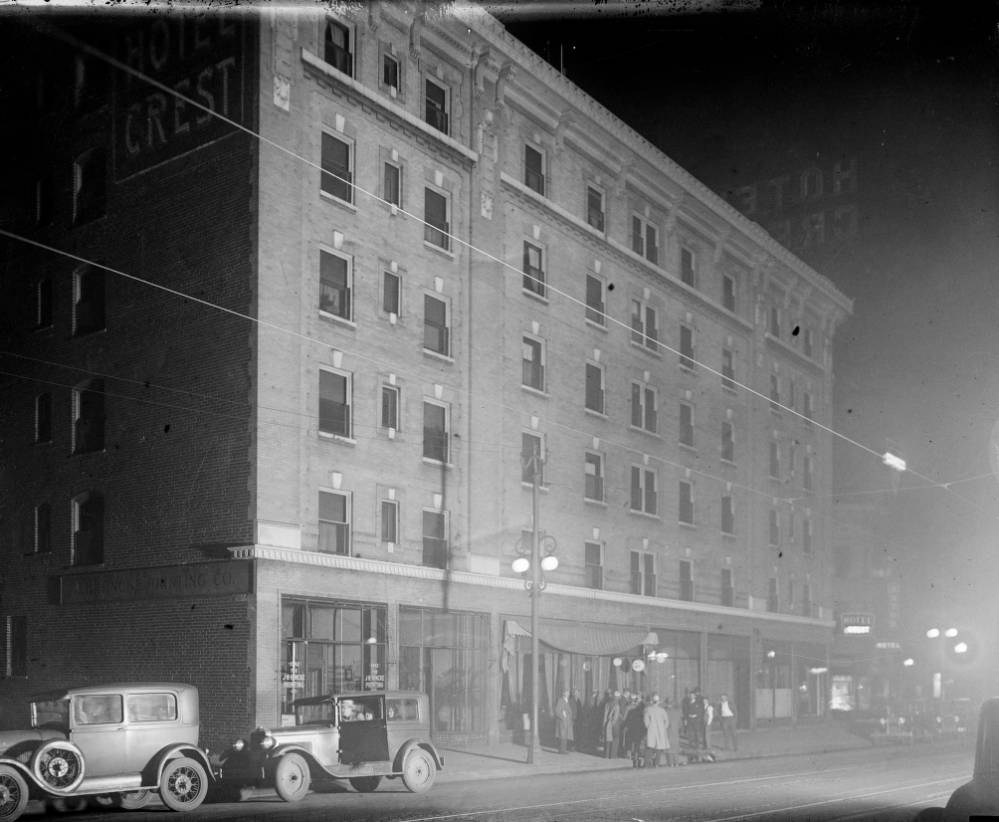

In the 1960s during the urban renewal craze in Denver (and in cities across the country) architectural preservationist Dana Crawford saved the 1400 block of Larimer Street from demolition. Other locations, including the area around the Hotel Crest were considered, but Crawford felt the block on Larimer Street was “advantageously located to become the upscale shopping center which she envisioned.”

ONE LINCOLN PARK


